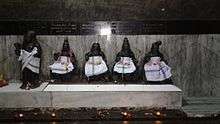Meykandar
Meykandar (Tamil: மெய்கண்டார், Meykaṇṭār, lit. the truth seer), also known as Meykanda Devar, was a 13th-century philosopher and theologian who contributed to the Shaiva Siddhanta school Shaivism.[1][2][3] His literary work known as Śiva Jñāna Bodham on Shaiva Siddhanta has enjoyed great vogue and prestige among Tamilians compared to other well-known Hindu philosophies such as Advaita of Adi Shankara and Vishistadvaita of Ramanuja.[4][5]
Meykandar | |
|---|---|
 The figures of Sundarar and four Santāṉa kuravars in which Meykandar appears second from left to right. Karur temple, Tamil Nadu. | |
| Personal | |
| Born | Swetavana Perumal |
| Died | 13th century CE |
| Religion | Hinduism |
| Known for | Expounded Saiva Siddhanta |
| Founder of | Tamil Siddhantism and Lineage of Santana Kuravar |
| Philosophy | Saiva Siddhanta |
| Religious career | |
| Guru | Rishi Paranjyoti |
| Literary works | Śiva Jñāna Bodham |
Background
| Part of a series on |
| Shaivism |
|---|
 |
|
Scriptures and texts
|
|
Philosophy
|
|
Practices |
|
Schools
Saiddhantika Non - Saiddhantika
|
|
Related
|
Meykandar was born to Achyuta Kalappālar and Mangalambikai, ardent devotees of Lord Shiva who lived in the Tirupennākadam village of present-day Cuddalore District, Tamil Nadu.[6] It is said that they were troubled over their childless state which led them to be counselled by their family guru, Sakalāgama Panditar, who advised them to do a penance at Thiruvenkadu Siva Temple.[4] As a result, conceived and gave birth to a boy. They named him "Swethavana perumāl", after the name of the deity at Thiruvenkadu.[7][8]
Swetavana Perumal was brought to his maternal hometown Thiruvennainallur by his uncle. One day while he was playing in the street, he was attracted by Rishi Paranjyoti, who "descended from Kailash".[5] Paranjyoti initiated Swetavana Perumal as his disciple and gave him the diksha Nāmam, "Mey Kandār", the Tamil equivalent of his guru's name, Satya njnana darshini.[9] Meykandar composed Śiva Jñāna Bodham, the core treatise of Southern Siddhanta tradition. It contains twelve aphorisms (Sutras) running to a total of forty lines, and deals with the nature of the three components of Saivism (Pati-Pashu-Pasam), and the means of attaining oneness with Siva.[10] Many researchers conclude that Śivajñānabodham might have been composed around 1223 CE.[11]
Santana Kuravar
Sakalāgama Panditar, the family guru of Meykandar, once visited Meykandar and surprisingly became his disciple. He, later known as Arulnandi Sivan, composed Shiva Njana Siddiyar and Irupa irupahthu, in which he seconded Meykandar's Śiva Jñāna Bodham. Arulnandi sivan's disciple Marai njana Sampandar was the guru of Umapati Sivan who composed another eight texts explaining Saiva Siddhanta. These four personages – Meykandar, Arulnandi Sivan, Marai njana Sampandar and Umapati Sivan are revered by the Tamil Siddhantins as "Santāna Kuravars" (Lineage of Gurus).[12]
Meykandar Siddhantism
Saiva Siddhanta Sampradaya was spread by Santana Kuravars during 13th and 14th centuries in Tamil land is known as "Meykandar Sampradaya" in philosophical perspective.[13] It is also considered as a branch of Nandinatha Sampradaya, which flourished from the eight direct disciples (Sanatkumarar, Sanakar, Sanadanar, Sananthanar, Shivayogamuni, Patanjali, Vyaghrapada, and Tirumular) of Nandinatha.[14] Meykandar Sampradaya is associated with the teachings of first disciple of Nandinatha – Sanatkumarar.[14]
There are totally fourteen texts of Santana Kuravar and others admired by Tamil Saivites as Meykanda Saathirangal[15] (Sastras of Meykandar or Sastras that perceived the truth). Though Saiva siddhanta is often identified as a pluralistic philosophy, it declares itself Vaidika Suddadvaita (Vedic Pure advaita) claiming that it interprets Advaita as it is.[16]
See more
- Saiva Siddhanta
- Sampradaya
References
- Subramuniyaswami, Satguru Sivaya (2003). Dancing with Siva: Hinduism's Contemporary Catechism. Himalayan Academy Publications. p. 253. ISBN 9780945497899.
- ́Sripatipandita (1936). The Śrīkara Bhāshya: Introduction Volume 1 of The Śrīkara Bhāshya: Being the Vīrasaiva Commentary on the Vēdānta Sūtras. Conjeeveram Hayavadana Rao, Akshaya Prakashan. ISBN 9788188643011.
- Contemporary Indian Literature, Volume 5. Shastry. S.L. 1965. p. 23.
- Siddalingaiah, T. B. (1979). Origin and Development of Saiva Siddhanta Upto 14th Century. Madurai Kamaraj University Central Cooperative Stores. p. 71.
- V. Raghavan (1978). Philosophers and Religious Leaders, Volume 1 Cultural leaders of India. Publication Division, Ministry of Information and Broadcasting, Government of India. p. 52.
- Violet, Paranjoti (1954). Śaiva Siddhānta. Luzac. p. 21.
- "Meykandar (மெய்கண்டார்) – Life History". Shaivam.org. Retrieved 5 March 2017.
- Collected Lectures on Saiva Siddhanta, 1946–1954. Annamalai University. 1965.
- Saiva Siddhanta, Volume 22. Saiva Siddhanta Mahasamajam. 1987. p. 51.
- Arunachalam, M. (1978). Outlines of Saivism Volume 2 of Peeps into Tamil culture. Gandhi Vidyalayam. pp. 29–40.
- "The Saiva Siddhanta". Siddhanta Deepika. 11: 108. 1994.
- Subodh Kapoor (2002). A Short Introduction to Saivism. ISBN 9788129100122.
- Mathew Chandrankunnel (2008). Philosophy of Quantum Mechanics. Global Vision Publishing House. p. 720. ISBN 9788182202580.
- Satguru Sivaya Subramuniyaswami (2003) "Dancing with Siva: Hinduism's Contemporary Catechism" Himalayan Academy Publications ISBN 9780945497899
- International Association of Sanskrit Studies (1985). Proceedings of the .... World Sanskrit Conference. Rashtriya Sanskrit Sansthan.
- Civañān̲a Mun̲ivar (1985). Sivajñāna Māpādiyam. Publications Division, Madurai Kamaraj University. p. 2.
